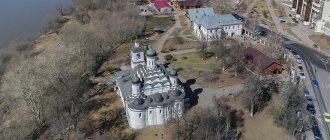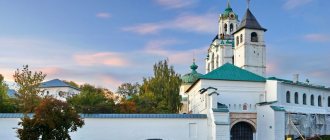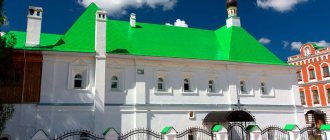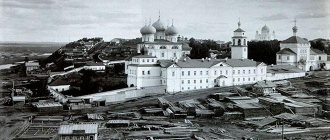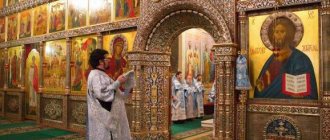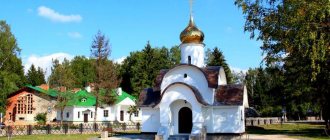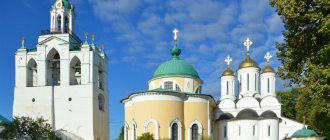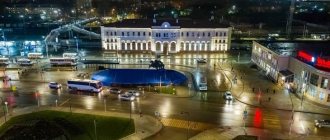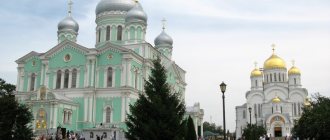Spaso-Andronikov Monastery (Russia, Moscow, Andronevskaya Square, 10)
Central Museum of Ancient Russian Culture and Art named after. Andrey Rublev
- Opening hours: Monday, Tuesday and Thursday from 14:00 to 21:00 (ticket office until 20:15) Friday, Saturday and Sunday from 11:00 to 18:00 (ticket office until 17:15)
- The exposition and exhibitions are closed on Wednesday
- territory is open daily from 9:00 to 21:00
- Telephone:
- Tour agency: +7-495-678-14-67, +7 (495) 678–98–03
- Website of the Andrei Rublev Museum
From the official website of the museum /www.rublev-museum.ru/abby/abby-history.aspx/: “The early history of the monastery is connected with the names of the Moscow Metropolitan St. Alexia, Rev. Sergius of Radonezh, Andronik and icon painter Andrei Rublev. According to hagiographic texts, the monastery was founded on the initiative of St. Alexy after returning from Constantinople (Constantinople) in the middle of the 14th century. He brings with him the icon “Savior Not Made by Hands”. As abbot, at the request of St. Alexy was made a student of the teacher. Sergius of Radonezh, Andronik. Having found “a suitable place,” the Metropolitan transfers the necessary funds to the monastery along with the icon and erects a cathedral in the name of the Savior Not Made by Hands, in fact, the Transfer of His Image to Constantinople (celebrated August 29, New Style).
History of the Spaso-Andronikov Monastery
Middle Ages
Hagiographic sources connect the construction of the monastery with the events of 1354. Bishop Alexy of Vladimir was heading to Constantinople to accept the rank of Metropolitan of Kyiv and All Rus'. On the way, he was caught in a severe storm. The saint swore before the Lord that if the journey was successfully completed, he would build a cathedral in Moscow in the Golden Horn Bay (near Istanbul). The safe arrival at the port coincided with the holiday in honor of the transfer of the Image of the Savior Not Made by Hands to Constantinople (Savior Not Made by Hands).
Soon, seven miles from the Kremlin, at the intersection of two strategically important directions - the busy Vladimir Highway and the road to the Golden Horde (Kolomna, Ryazan), they began to build a monastery. He was destined to become a lookout point.
The monks warned Muscovites more than once about the approach of the enemy. But the monastery could not defend itself; in 1368 and 1371 it was plundered by Lithuanian troops, in 1451 and 1571 by the Golden Horde, and in 1611 by Polish invaders.
The consecration of the main building - the wooden Spassky Cathedral - took place on August 16, 1357. The ceremony was held with a particularly revered Christian shrine - the icon of the Savior Not Made by Hands. For her sake, Metropolitan Alexy visited Constantinople again in 1356.
Monk Andronik, a disciple of St. Sergius of Radonezh, was appointed abbot of the new monastery. Under him, Andrei Rublev took monastic vows. In 1425-1427, he, together with another outstanding monk-icon painter Daniil Cherny, painted the walls of the new Spassky Cathedral made of white stone. The temple is still functioning. It was erected on the basis of a wooden predecessor, which, in turn, grew on the site of the first building that burned down in 1368.
In 1380, the monastery was visited by Dmitry Donskoy, returning from the victorious end of the Battle of Kulikovo. According to legend, the fallen defenders of Moscow were laid to rest here. The tradition of burying outstanding compatriots on the territory of the monastery survived until the beginning of the 20th century.
In 1395, after the death of Andronik of Moscow, his comrade Savva became abbot. The monastery was rebuilt and expanded. The famous isographers continued to work on the frescoes until 1428, when both died during the plague epidemic. Abbots Andronik and Savva, icon painters Andrei Rublev and Daniil Cherny were buried on the territory of the monastery. They are revered by the Russian Orthodox Church as saints.
In 1439, the Andronikov Monastery received the status of archimandry (the abbots were awarded one of the highest clergy in Orthodoxy), and its influence on various spheres of public life increased. The territory of the monastery gradually turned into a large-scale, well-fortified architectural complex. By the end of the 17th century, walls, the Holy Gate with a gate church, a refectory, a rector's and fraternal buildings were erected. Evdokia Lopukhina in 1691 gave impetus to the construction of a temple over the refectory, the construction of new churches and chapels, and a family tomb.
In the XIV-XVII centuries, the monastery was a center for the correspondence of books. Many of the works of St. Maxim the Greek (according to Academician Dmitry Likhachev, “the first intellectual in Rus'”) were kept here. Since 1475, bricks for the construction of the Kremlin began to be made in the adjacent monastery settlement. The monastery also had assigned peasants (by 1700 - 210 households). In addition, the monastery served as a place of imprisonment for clergy (Novgorod Bishop Serapion, Archpriest Avvakum).
XVIII-XX centuries
Beginning in 1701, the monastery's income gradually declined - as a result of the reform activities of Peter I. Nevertheless, at the end of the century it was one of the richest monasteries in Moscow. In her possession were the lands under the village (5.6 hectares), hayfields (4 hectares) and inconveniences (4.5 hectares).
Part of the funds went to shelters, correctional homes, and hospitals. In 1748, the archive and library were badly damaged by another Moscow fire. By the end of the 18th century, paintings disappeared from the walls of the Spassky Cathedral. In 1763-1779, the building was restored (the frescoes were not restored) and completed (a covered porch appeared).
In 1803, the courtyard was decorated with a church with a 72-meter copy of the bell tower of the Kiev Pechersk Lavra (built at the expense of the merchant S.P. Vasiliev). The only thing higher in Moscow was the Ivan the Great Bell Tower. The author of the projects is the famous Moscow architect Rodion Kazakov, a student of Matvey Kazakov (the main architect of Moscow in the second half of the 18th - early 19th centuries).
In 1812, a fire destroyed part of the property and provoked separate destruction: the dome and drum of the main cathedral fell, and the iconostasis burned down. Before this, soldiers of Napoleon's army plundered the monastery. The most valuable items were preserved - the monks took them out and hid them in advance. Many famous and unknown heroes of the Patriotic War of 1812 rested in the necropolis of the Spaso-Andronikov Monastery.
In 1846-1850, the appearance of the cathedral changed significantly. In accordance with the design of the architect Gerasimov, two chapels were erected, the appearance of the porches was changed, kokoshniks and zakomars were covered with a hipped roof, and an octagonal drum was installed under the tent structure. The last expressive building of this time is the church in honor of the holy martyr Evgraf with the tomb of the Molchanov merchant family (1874).
In 1918, the monastery was closed by order of the Soviet authorities. By this time (at the end of 1917) 17 monks and a novice lived in it. The territory was placed at the disposal of the Cheka. One of the first concentration camps for political opponents was set up here.
In 1922-1928, the monastery was occupied by a colony for street children, then by workers. 200 living rooms were equipped in ancient buildings (including temples). In the 30s and 40s, there were institutions of the People's Commissariat of Defense here.
During the years of Soviet power, the architectural complex suffered significant destruction. By 1927, the necropolis was destroyed (a football ground was made in its place); by 1932, the bell tower and part of the walls and towers were dismantled. The Holy Gate and the Church of the Nativity of Our Lady also disappeared. The Spassky Cathedral was opened until 1924.
For the first time, the question of reviving the monument was raised by researchers of Moscow architecture P. N. Maksimov and B. A. Ognev in the late 30s. They established that the Spassky Cathedral is a unique building of the 15th century. In 1947, according to a resolution of the Council of Ministers of the USSR, an architectural museum-reserve named after Andrei Rublev began to be created in the Andronikov Monastery. It was opened to the public in 1960, which, on the initiative of UNESCO, was dedicated to the 600th anniversary of the birth of the greatest of ancient Russian painters.
In 1959-1960, the Spassky Cathedral was restored to its original appearance, with a dome and kokoshniks. Since 1989 it has operated as a parish church. In 1996, the icon of the first abbots returned to its native shelter.
XXI Century
In 1998, the parish of the Spassky Cathedral restored rights to the territory of the former necropolis. In 2000-2015, a single-domed temple was built on this site in the name of the Holy Blessed Grand Duke Dmitry Donskoy. The author of the project, architect A.V. Klimochkin, gave the modern building the features of early Moscow architecture (XIV - early XV centuries).
In 2022, the Russian Orthodox Church claimed rights to the buildings of the Andronikov Monastery and asked the Federal Property Management Agency to transfer them to the Russian Orthodox Church for use.
The foundation of the monastery and pages of its history
The appearance of the Spaso-Andronikov Monastery is inextricably linked with the name of Moscow Metropolitan Alexy. A legend that has survived to this day tells of an episode that played an important role in the founding of the monastery. On the way from Constantinople, the ship on which the bishop was staying was caught in a strong storm. Saint Alexis prayed tirelessly and vowed to erect a temple in honor of the saint revered by the church on the day when the ship safely reached land.
The Metropolitan was not slow to fulfill his vow, and in 1360 the monastery was founded, and a student of Sergei of Radonezh named Andronik became its abbot. For the foundation of the monastery, the steep bank of the Yauza was chosen at the confluence of the Zolotoy Rozhok stream, a place where important routes to the Golden Horde and Constantinople passed. This strategic position played an important role for the monastery in the historical and military events of Rus'.
The squads of Dmitry Donskoy moved past its walls to fight on the Kulikovo Field. Warriors from the battlefield were also met here. The soldiers led by Prince Vasily Dmitrievich took the same route to fight Tamerlane.
The monastery had to survive the invasion of the troops of Khan Tokhtamysh and Devlet-Girey, Polish troops and more than one devastation. After raids and destruction, the monastery was again restored from the ashes, grew, and was rebuilt.
During Soviet times, the monastery was threatened with demolition. But despite all the twists and turns of history, and also thanks to the efforts of the architect and restorer P. Baranovsky and the artist I. Grabar, who sought to preserve the Spaso-Andronikov Monastery, it survived. Although some of the buildings were still destroyed. This fate befell the gate bell tower; it was dismantled in the 30s of the last century; the necropolis, which was the eternal resting place of many famous noble families, was also destroyed.
Architectural ensemble of the monastery
Those entering the monastery gates are greeted by two main cathedrals - Spassky and Archangel Michael. The unique architectural appearance of the monastery also includes a refectory, abbot's chambers, fraternal chambers, the Lopukhins' tomb, a religious school, powerful stone walls with towers. Some of the buildings deserve special attention.
Spassky Cathedral is the main building on the territory of the complex. This is a real alien from the past, the most ancient stone temple in Moscow. After repeated destruction, rebuilding and reconstruction, in 1960 it became the same as it was created in 1410-1427.
This is a four-pillar, single-domed cathedral made of white stone with a facade divided into three parts. Below is a high basement. The building is an original, dynamic, upward-facing structure with stepped volumes. Russian architects developed this type of building in pre-Mongol times, and it came into fashion in the 14th-15th centuries.
Numerous decorative arches, narrow lancet windows, and the original medallion on the facade make the building similar to exquisite examples of European Gothic. White stone as a building material and the form of perspective portals are traditions of the architecture of Vladimir-Suzdal Rus' of the pre-Mongol period.
Some fragments of the rich painting on the walls remain. You can consider floral and zoomorphic ornaments. Small areas of painting on the sides of the windows are elements of frescoes by Daniil Cherny and Andrei Rublev.
The elegant three-tiered Church of the Archangel Michael is the tallest building in the complex. An expressive example of Moscow baroque was created in 1694-1739 at the expense of Tsarina Evdokia Lopukhina, the first wife of Peter I. One of the thrones was consecrated in the name of St. Alexis. That was the name of the prince in whose honor the temple was built.
Now the building houses the Museum of Ancient Russian Art. Its collection consists of masterpieces of painting (XII-XVIII centuries), sculpture, arts and crafts, icon painting, early printed and handwritten books. Visitors can admire the works of Andrei Rublev. The Znamensky chapel is the largest tomb of the boyar family of Lopukhins.
Part of the museum exhibition is located in the refectory chamber adjacent to the temple. The two-tiered brick building was erected in 1504-1506 under Archimandrite Mitrophania, the confessor of Ivan III. The Grand Duke built a country residence on the opposite bank of the Yauza, opposite the monastery. The refectory became a link between the interior of the monastery and the outside world. Ivan III could come to his confessor at any time, remaining unnoticed.
The facade of the refectory is devoid of any special frills - a cubic shape, a high hipped roof, a minimum of decor. The most expressive detail is the painted ceramic tiles framing the upper part of the walls. The organization of the internal space coincides with the structure of the Faceted Chamber in the Kremlin. Downstairs there were housekeeping services. The second floor served as the main hall.
Shrines of the monastery
Within the walls of the Spaso-Andronikov monastery there are miraculous shrines of Orthodoxy:
- image of the Savior Not Made by Hands,
- 6 relics,
- two parallel burials,
- Icon of Saints Andronicus and Savva of Moscow.
The main and main shrine of the monastery is considered to be the Image of the Savior Not Made by Hands. It was in front of her that Alexy made a vow to build a temple. For some time it was considered lost and only in 1999 it was found in the Historical Museum of the Novodevichy Convent. Now a list of this image has been placed in the Spassky Cathedral.
Also during the search work, an icon of Saints Sava and Andronicus was discovered. She was solemnly transferred to the Spassky Cathedral, where she took a place of honor. Another find was 6 relics that were discovered in the ancient altar of the cathedral. Two parallel burials were also found, which carried fragrances.
How to get to the Spaso-Andronikov Monastery
You can get to the Spaso-Andronikov Monastery in one of the three most convenient ways: by metro (from the stations “Ploshchad Ilyicha”, “Rimskaya”, “Chkalovskaya”), ground public transport (bus or tram) or car.
Metro
The closest stations to the Spaso-Andronikov Monastery are the following Moscow metro stations: “Ilyich Square” (Kalininskaya line, 750 m), “Rimskaya” (Lyublinsko-Dmitrovskaya line, 790 m), “Chkalovskaya” (Lyublinsko-Dmitrovskaya line, 1.3 km .).
From the metro station "Ploshchad Ilyicha"
Having reached the Ilyich Square metro station, go up to the city using exit No. 1. Coming out of the metro into the city, follow Gzhelsky Lane, which smoothly flows into Andronevsky Proezd, ~750 m, after which you will see the architectural ensemble of the Spaso-Andronikov Monastery.
MoscowYandex.Maps
From the Rimskaya metro station
Having reached the Rimskaya metro station, go up to the city using exit No. 2. Coming out of the metro into the city, follow Sergius of Radonezh Street ~800 m., then, having reached the underground pedestrian crossing, cross the roadway and move straight ~300 m., after which you will see the walls of the Spaso-Andronikov Monastery.
MoscowYandex.Maps
Architectural features of the temple
The ancient Cathedral of the Savior Not Made by Hands is a cross-domed church with one dome and 4 internal supports, an example of early Moscow architecture. The compositional peculiarity of the cathedral is expressed in the dynamic tension of the silhouette, the solemn aspiration of the entire structure upward.
The Spassky Cathedral of the Andronikov Monastery is made of rectangular limestone blocks with a polished front surface. White stone for construction was mined near the monastery, and the Kremlin buildings were built from the same limestone.
The main volume in the form of a small cube is installed on a high basement. In the upper part, the structure is decorated with a decorative cascade: one row of kokomars in the form of a semicircle with a point above the middle of the arc and two rows of kokoshniks. The light drum ends in a hemispherical dome topped with a cross.
On three sides, the temple structure is complemented by covered extensions with promising entrance portals. The ends of the portals and narrow windows have a lancet shape. White stone stairs leading to the portals emphasize the slender silhouette of the prayer building.
In the eastern part, three altar semicircular apses, covered with semi-domes, adjoin the base of the temple. The facades are divided by projecting pillars (pilasters), which coincide with the internal projections and interior arches.
Above the western entrance portal there is a round medallion with the image of the Savior Not Made by Hands. The picturesque painting was made during restoration using innovative phosphate paints that are resistant to the adverse influence of climatic conditions. The drawing reproduces the lost fresco “The Savior Not Made by Hands,” painted in the 15th century by Andrei Rublev.
The Spassky Cathedral, with its architectural individuality and perfection of lines, became an inspired model for architects of the 15th and 16th centuries. Craftsmen from all Russian lands visited the Andronikov Monastery to see the majestic temple, and then reproduce its architectural features in new church buildings.
A famous copy of the Spassky Cathedral is the Cathedral of the Nativity of the Virgin Mary (1505), located in the Nativity of the Virgin Mary Monastery in Moscow.
